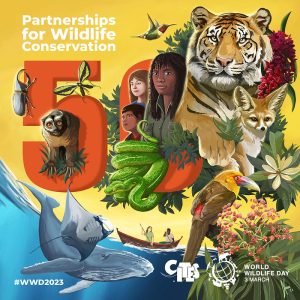World Wildlife Day, opens a new window is a United Nations International day held on March 3 to celebrate all the world's wild animals and plants and the contribution that they make to our lives and the health of the planet. Millions of people around the world rely on wildlife and biodiversity-based resources as a source of their livelihoods and economic opportunities. Nature helps us to meet all our needs, from food, to fuel, medicines, housing and clothing, it is also essential for our mental health. The 2023 theme is "Partnerships for Wildlife Conservation", opens a new window. This theme is meant to celebrate conservation efforts at all levels, from international to local. The theme has two sub-topics: Marine Life & Oceans, Business & Finance. With 70% of the planet covered by water, the impact of marine conservation is incredibly important. Conservation efforts need to be funded and successful partnerships for conservation must find ways of including business if we are to reverse the loss in biodiversity.
In Ontario, there are over 240 plant and animal species that are at risk. The Government of Ontario provides the official Species at Risk in Ontario (SARO), opens a new window list. The Endangered Species Act, opens a new window provides science-based assessment, automatic legal protection once a species is classified as endangered or threatened, and habitat protection. Explore more about some of the species at risk in Ontario and Canada with the resources below and learn how you can take action.

The greatest diversity of Canadian Turtles, opens a new window live in Southern Ontario, they can be found in lakes, ponds, rivers, marshes and bogs. In Ontario 7 of 8 turtle species are species at risk. One of those species the Blanding's Turtle, opens a new window - also known as Ontario's smiling turtle - is being threatened by loss of habitat, motor vehicles, and predators. The Toronto Zoo's Adopt-A-Pond Wetland Conservation Program reintroduces baby Blanding's Turtles into the wetlands of the Rouge National Urban Park, opens a new window. Take action and reduce road mortality, opens a new window with this video on How to Help a Turtle Cross the Road, opens a new window. Turtles are most seen in June when they travel to nesting sites, take action and report turtle sightings to the Ontario Turtle Tally on the Adopt-a-Pond website or iOS and Android, opens a new window apps.
Ontario bats, opens a new window contribute to the healthy structure of food chains in our ecosystems. According to the Native Bat Conservation Program, opens a new window, 4 of 8 bat species in Ontario have been listed as endangered since 2012. An invasive fungus was introduced by accident to North America around 2006, infecting caves and hibernating bats and reducing their populations by 90% in infected areas. This fungal infection is called white-nose syndrome, opens a new window (WNS). Take action by learning how to limit the spread of this fungal disease in this video by Parks Canada. Take action if you know a building, natural structure or bat house with a summer bat colony, report the location of the colony to Neighbourhood Bat Watch, opens a new window. If you create and install a bat house, opens a new window, you can register it's location and help track where bats are living. Data collected through batwatch.ca helps to monitor and develop strategies to conserve these important animals.

Ontario mussels contribute to healthy aquatic ecosystems in our lakes and rivers. They can live up to 100 years and travel as far as 1 meter during their lifetime. Freshwater mussels are sensitive to changes in habitat from pollution, water levels and temperature and other invasive species. Currently, 65% of freshwater mussel species are endangered in Ontario. Take action next time you see a freshwater mussel at the cottage or on a riverside walk. Report your sighting using the Clam Counter app available for iOS, opens a new window and Android, opens a new window. The Clam Counter app is developed by the Toronto Zoo and Ocean and Fisheries Canada to help determine the status of freshwater mussel populations and supplement conservation efforts.

The Polar Bear is an icon of Canadian wildlife heritage, and has great cultural, opens a new window, spiritual and economic, opens a new window significance to the Inuit and northern communities. Canadian Polar bears are vulnerable to becoming a threatened species according to the International Union for Conservation Red List, opens a new window. In Canada, polar bears are found in ice-covered regions from the Yukon to Newfoundland and Labrador. According to the Nature Conservancy Canada, opens a new window, two-thirds of the global population of polar bears live in Canada and the most southernly polar bears live along the coast of James Bay in Ontario. Polar bears are facing threats from climate change, pollution, resource extraction and human conflict. The effects of climate change has reduced the amount of arctic sea ice, opens a new window, impacting the polar bear's primary habitat. Take action and learn more about Conservation of Polar Bears in Canada, opens a new window, the Polar Bear management plan, opens a new window, and the Ontario Polar Bear Recovery Strategy, opens a new window.
Explore the reading lists below and learn more ways to take action this World Wildlife Day from the Canadian Wildlife Federation', opens a new windows online webinars, opens a new window:
- Gardening with Wildlife in Mind: Creating a Wildlife-friendly Garden, opens a new window
- iNaturalist Webinar Series: How Citizen Science provides key data for Endangered Species, opens a new window
- Water We Without Oceans?, opens a new window
- Pollinator Series. The Meadoway: Planning and Restoring Pollinator Habitat in a Utility Corridor in Toronto, Ontario., opens a new window



Add a comment to: Canadian Wildlife